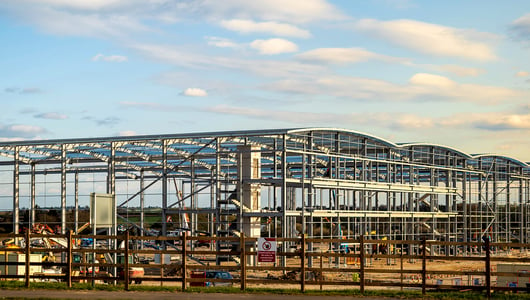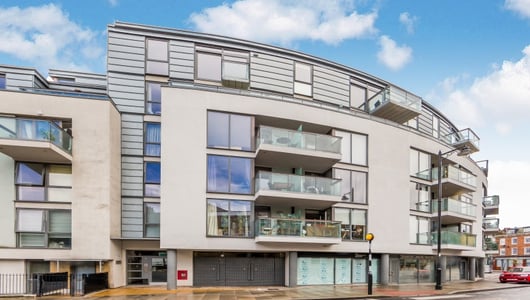UK economic update Autumn 2023

Stronger signals that interest rates are nearing their peaks
Updated 18 October 2023
The key economic move over the last few months was the Bank of England’s decision not to raise interest rates in September. Keeping the rate fixed at 5.25% (still the highest rate in 15 years) was the first time the Bank’s rate-setting committee had not raised rates since November 2021, and it indicated that the Bank felt that inflation was starting to come under control. The official inflation data showed that the pace of price rises in the UK fell to 6.7% in August, down from a peak of 11.1% in October last year. Core inflation also fell back slightly in August. Inflation stayed pegged at 6.7% in September, a slight surprise to the upside. Core inflation ticked down again to 6.1%. The Bank’s rate setters will take this into consideration when it next meets in early November.

The central bank was careful not to rule out increasing interest rates again in the future, and economists believe that rates will stay elevated until well into next year before they start to fall back. There is an additional concern than increased geopolitical tensions could push oil prices higher, which would reverse some of the falls in inflation.
Slightly weaker economic data, both in terms of GDP growth and employment levels, also indicate that the Bank’s moves over the last two years are having an impact. The IMF released new forecasts indicating that the UK economy would grow by just 0.6% next year, which attracted some criticism for being too gloomy. But the Treasury’s monitor of independent forecasts showed that UK economists expect 0.5% growth in 2024. The IMF also said interest rates would stay elevated at around 5% until 2028, but some economists predict a rapid decline in rates in 2025.
Homeowners shifting off very low-rate fixed-rate mortgage deals agreed two, three or five years ago will also feel the impact of higher interest rates over the coming year. It’s estimated that 1.6 million homeowners will have re-mortgage, often paying a significantly higher monthly sum, this year alone. The Bank of England has calculated that around one million borrowers will pay an extra £500 a month on their mortgage by 2026.
The good news for borrowers is that there is increasing competition in the mortgage market, which is putting some downward pressure on home loan rates. Still, a return to ultra-low mortgage rates experienced between 2010 and 2021 at any time in the short or medium-term is very unlikely, which will put more pressure on some household finances through 2024 and beyond.

The information provided in this report is the sole property of Cluttons LLP and provides basic information and not legal advice. It must not be copied, reproduced or transmitted in any form or by any means, either in whole or in part, without the prior written consent of Cluttons LLP. The information contained in this report has been obtained from sources generally regarded to be reliable. However, no representation is made, or warranty given, in respect of the accuracy of this information. Cluttons LLP does not accept any liability in negligence or otherwise for any loss or damage suffered by any party resulting from reliance on this publication.
Latest research

UK & London rental market update Spring/Summer 2024
Continued demand for rental property amid constrained supply delivers rental growth .
UK & London sales market update Spring/Summer 2024
Price declines are reversing and activity up from Q4 2023, but pricing still remains key for new listings.
Economic update Spring/Summer 2024
The UK economy has likely emerged from recession, although growth remains muted. Inflation is falling and rates cuts are on the cards this year, which will translate into lower mortgage rates.
Commercial market update Spring 2024
It’s now widely accepted that interest rates have peaked, the key question now is when will the central bank start to cut rates, and how low will they go in the coming year.
Office market update Spring 2024
The structural change in the office market is ongoing, with strong appetite for best-in-class office space which meets high net-zero requirements and insipid demand for secondary or tertiary space. The investment market was quiet overall in 2023, although some notable deals were struck where pricing was competitive.
Retail market update Spring 2024
Take-up rose towards the end of 2023, but overall vacancy rates are flattered by the lack of supply in the market. The bright spot for landlords is luxury retail and retail parks, where consumer demand is still relatively stronger.
Industrial market update Spring 2024
Vacancy rates creep up and rents ease. The recalibration of the Industrial market after the pandemic uplift continues, but overall, the sector continues to outperform compared to other asset classes.
UK & London rental market update Spring 2024
Demand in the UK rental market hit new highs in 2022 and early 2023, and is now moderating, but is still higher than pre-pandemic averages.
UK & London sales market update Spring 2024
Average annual UK house prices falls hit a low of -5% in September last year, but have since moderated to around -2%.
Economic update Spring 2024
The economy grew more than expected in November, according to the latest data from the ONS, but there is still a risk that the UK could dip into recession.
Residential Forecast 2024
Our outlook for the residential market this year and into 2025.
Commercial market update Winter 2023
The Bank of England’s decision to keep the base rate on hold at 5.25% for the second consecutive time in November has raised the prospect that interest rates are at their peak.
Office market update Winter 2023
Flight to quality continues. There has never been such a distinct divergence between prime and secondary property, and this is still being driven by companies adjusting to changing working patterns as well as a desire to meet higher net-zero targets.
Industrial market update Winter 2023
Slowing rental growth. Robust occupational market conditions amid tight supply are helping to maintain a continued confidence after significant repricing in the sector.
Retail market update Winter 2023
Slowing market. Prime high street assets are among the best performing within retail – these assets have stabilised and there is opportunity for future rental growth where values have been rebased.
UK & London lettings update Autumn 2023
The ONS measure of rental growth shows London rents up by 6% in a slow climb from 0.1% at the start of 2022. In prime London, the bounce-back in rents was much faster and stronger.
UK & London sales market update Autumn 2023
Average house prices continue their downward trajectory, with values falling 5.3% in the year to September. Our quarterly update examines the latest trends in the UK, London, and prime London sales markets.
Hyde Park market focus: Autumn 2023
A new seasonal trend? The housing market is traditionally quite seasonal, with busy periods in Spring, Autumn and the New Year, as buyers and movers use markers of the year as a goal to settle into a new home.
Wapping & Limehouse market focus: Autumn 2023
The Bank of England has raised the base rate multiple times this year, but the messaging from rate-setters at the central bank is that we could be nearing the peak. This has allowed the money market rates, which determine the price of fixed-rate mortgage lending to fall back a little.
Shad Thames market focus: Autumn 2023
Activity in the London sales market has eased this year compared to a very busy 2022, as rising interest rates and a more uncertain economic outlook affect the whole UK housing market.
Commercial market update Autumn 2023
Will they? Won’t they? This is the key question around whether the UK’s base rate will exceed 5.75%. There have been enough mixed messages to muddy the waters – inflation data released in June showed that inflation was stuck at 8.7% in May, which prompted forecasts that the base rate would peak at 6.5% from the current rate of 5.25%.
Office market update Autumn 2023
UK office vacancy rate continues to climb. Weak demand and strong supply are resulting in an ever-rising vacancy rate for offices across the UK, which has hit 7.7%, up from less than 5% before the pandemic.
Retail market update Autumn 2023
The retail environment remains challenging. The rising cost of living, and recent disappointing weather have led to a further tick down in overall sales.
Industrial market update Autumn 2023
Vacancy rate remains low. Net absorption of industrial space dipped into negative territory in Q2 2023 for the first time in 11 years as take up fell back to levels last seen before the pandemic.
Prime London sales Q3 2023
Price growth in the Greater London market was more subdued than in some other parts of the country during the pandemic.
Prime London rental Q3 2023
The bounce back in rental demand after the pandemic amid constrained supply created a turbo-charged market in 2022. There is still very strong rental demand compared to pre-pandemic norms, but it has now plateau-ed in many areas, or has started to recede slightly.
UK & London lettings update Q3 2023
Rents continue to rise, but a slight loosening in supply means the pace of growth is beginning to ease in many regions.
UK & London sales market update Q3 2023
Average house prices continue to fall, although at a relatively modest rate. Average values are down 3.5% on the year.
UK economic outlook Q3 2023
The economy settled down relatively quickly from the shock of the mini-budget in September last year and the resulting spike in gilt rates and mortgage rates.
Commercial market update Q2 2023
The UK’s economic mood music has been more upbeat so far this year than many would have anticipated in the wake of the mini-budget last year. This culminated in the IMF, traditionally circumspect about the UK’s economic outlook, confirming in late May that the country would not enter recession this year, contrary to its earlier forecasts.
Office market update Q2 2023
Office take-up gained some momentum towards the end of Q1 as employees continue to return to the workplace in greater numbers. But overall demand for office space remains muted compared to historical norms.
Retail market update Q2 2023
Retail sales fell back in May after rising slightly in April, according to a survey from the CBI, but the overall outlook is slightly more upbeat than at the beginning of the year as consumer confidence continues to climb and the prospect of lower energy bills is factored in.
Industrial market update Q2 2023
Average industrial property yields, according to MSCI, which softened sharply last year remained largely unchanged in Q1 2023, as the market absorbed the new economic landscape in the UK.
UK economic outlook Q2 2023
Higher than expected inflation dampens expectations for UK economy. Inflation data was higher than expected in May, which has weighed on business confidence, and has pushed interest rate expectations, and the cost of borrowing, higher.
UK & London lettings market update Q2 2023
Rents continue to rise, but the pace of growth is beginning to ease in many regions. Tight levels of supply are still underpinning rental growth.
UK & London sales market update Q2 2023
March marked the seventh consecutive month of monthly price falls in house prices across the UK, taking the annual decline to 3.1%.
Market focus: Shad Thames
The landscape for the housing market has changed, as the bank base rate is now higher than the ultra-low rates of the last decade.
Market focus: Wapping & Limehouse
Sentiment across the prime London market has improved since the start of this year after the political and money market upheavals in the wake of September’s mini-budget.
Commercial market update Q1 2023
The bond vs property yield spread ticked up in Q4 but remains nearly the narrowest in a decade.
Retail market update Q1 2023
Retail sales ticked up slightly in January but are still down on a three-monthly basis from the post-pandemic highs in the summer of 2021.
Industrial market update Q1 2023
The strong performance in this sector over the last few years mean that the upheaval caused by rising interest rates and the September’s mini-budget, which caused a surge in gilt yields, was more pronounced than other sectors.
Office market update Q1 2023
UK office vacancy rate rises, but masks a two-tier market.
Residential lettings market update Q1 2023
Rents continue to rise strongly across the UK as demand flows back into city centres where supply is tight.
UK and London sales market update Q1 2023
Average house price growth slowed sharply at the end of last year and continued to ease in January.
UK economic outlook Q1 2023
The economic outlook for the UK is challenging this year, but there is growing consensus that the downturn will not be as long as previously expected.
Residential forecasts Q4 2022
After months of political upheaval, the landscape has calmed in recent weeks, providing a greater sense of stability in markets than at any time since mid-September.
Commercial market update Q3 2022
Bond yields have settled down, but property yields are exposed to some repricing as investors take into account higher borrowing costs.
Industrial market update Q3 2022
Rents and capital values surged this year in response to high levels of demand for occupiers and investors alike.
Office market update Q3 2022
The central theme in this sector is the flight to quality by investors and occupiers alike.
Retail market update Q3 2022
This sector was hit hardest by Covid and the cost-of-living led recession will likely deliver another blow.
Forecasts and outlook Q3 2022
The recent political upheavals have exacerbated the uncertainty around the UK’s economic outlook. But behind the headlines, housing data has for some months been pointing to a slowing market after several years of record-high activity.
Wider South East Q3 2022
House price growth slowed slightly in the wider South East in Q3, but are still up 10% year on year.
London sales and rental review Q3 2022
Average house prices across London continued register growth in Q3, but at a more modest rate than other regions.
UK economic outlook Q3 2022
Months of political upheaval has served to increase the UK’s economic uncertainty in recent months as policy U-turns added significantly to existing market volatility.
Development review Q3 2022
The supply of new homes at national level was very much in line with recent trends in Q3, but the outlook is turning negative due to weakness in the wider housing market and the impending end of Help to Buy.
UK rental review Q3 2022
Average UK rents continue to rise strongly, with double-digit growth in most regions in Q3.
UK sales review Q3 2022
Official data continues to show strong price growth for average house prices, and high activity levels.
Commercial market update Q2 2022
Economy is slowing and, early suggestions that we may avoid recession have been swept aside by the Bank of England following on from their August meeting.
Office market update Q2 2022
New hybrid model or edging back to prior status quo?
Industrial market update Q2 2022
Average industrial yields largely held steady for Q2, with the South East at 2.9% and the rest of the UK at 4.2%.
Retail market update Q2 2022
Will recession torpedo Covid recovery?
Forecast and outlook Q2 2022
Q2 saw the first small signs that the struggling economy was starting to impact the housing market, but some forecasters are still upgrading their growth expectations for 2022 based on the very high levels seen in the first half of the year.
Wider South East Q2 2022
Annual house price and rental growth remained around the 10% level in the wider South East in Q2, broadly continuing trends from earlier this year and staying in line with national trends.
UK economic outlook Q2 2002
Q2 saw further volatility for the economic recovery, with monthly GDP growth in May above expectations but other indicators turning increasingly negative.
London sales and rental review Q2 2022
Annual rental growth increased to around 15% in London in Q2, taking values beyond pre-pandemic levels.
Development review Q2 2022
At the national level housebuilding recorded a positive Q2, with output slightly ahead of recent trends.
UK rental review Q2 2022
Rental growth across the country accelerated further in Q2 as demand stayed high and there was only a limited response on the supply side.
UK sales review Q2 2022
The UK housing market continued to look strong in Q2 despite higher mortgage rates and the rising cost-of-living.
Industrial market update Q1 2022
The rent rise continues: If the classical economists’ definition of inflation being ‘too much money chasing too few goods’ needed a perfect illustration that the industrial sector is it.
Office market update Q1 2022
Historically there has been a very strong link between employment growth and increased demand for office space. The employment market is one part of the economy that is weathering the current storm well.
Retail market update Q1 2022
with so many bad news headlines over the cost-of-living crisis and geopolitical uncertainty, it is no surprise that consumer confidence has faltered and dramatically so.
Commercial market update Q1 2022
The commercial real estate sector has been through an extraordinary year, outperforming other asset classes with total returns of 23.9% over the past 12 months.
Forecasts and outlook Q1 2022
At national level the housing market has so far defied these issues but affordability is starting to look stretched and the expected further rises in inflation and mortgage rates are likely to dampen growth.
Wider South East Q1 2022
Both sales and rental values continued to grow strongly across the wider South East in Q1.
London sales and rental review Q1 2022
sales market saw further price growth in Q1, but at a slower rate than the rest of the country.
UK economic outlook Q1 2022
The economic recovery stuttered in Q1 due to another Covid variant, although many measures are back to their pre-pandemic levels.
Development review Q1 2022
So far 2022 has been business as usual for housebuilding, with output very much in line with recent trends both nationally and in London.
UK rental market Q1 2022
The rental market started 2022 much as it left 2021, with demand well ahead of supply in all regions, rental growth over 10%, and huge competition for properties.
UK Sales review Q1 2022
Demand remained ahead of supply in Q1, leading to high levels of activity and price growth continuing the trends from 2021.
Commercial market update Q4 2021
It has been a long pandemic, and Omicron provided a sharp reminder that it might not be over quite yet. Despite this, there are signs of recovery in all sectors.
Industrial market update Q4 2021
Rental growth continues to rise, hitting 7.2% a year in Q4 2021. Industrial space under construction is at the highest level ever recorded.
Office market update Q4 2021
Large year-end London office deals show confidence in the outlook, but TfL passenger volumes took another hit from Omicron in December.
Retail market update Q4 2021
Slide in retail rents halts, but inflation and interest rates pose a threat as cost-of-living bites.
UK economic outlook Q4 2021
The economy grew steadily in Q4 as it continued to recover from pandemic restrictions, with employment data also looking good.
Forecasts & Outlook Q4 2021
The economy continues to recover and GDP finally returned to pre-pandemic levels in Q4. More expansion is expected in 2022, but cost of living pressures are likely to limit growth in the short term.
Wider South East Q4 2021
House prices and rents across the wider South East grew strongly in Q4, with annual increases of around 10% – in line with the national picture.
London sales & rental review Q4 2021
The sales and rental markets in London both showed strong growth in Q4, but overall have not quite kept pace with the rest of the country through the pandemic period.
Development review Q4 2021
The end of 2021 saw housing supply broadly continuing in line with recent trends at national level and in London, having now recovered to pre-pandemic levels but, unlike second hand market activity, not surpassed them.
UK rental market Q4 2021
Rental growth was very high in 2021, as high as 10% at national level on Rightmove’s index. This is driven by demand continuing to outstrip supply across most regions, property types and price points.
UK sales market Q4 2021
Q4 was the first quarter for over a year with no stamp duty discount available, but the sales market maintained momentum and finished the year with double-digit price growth. Transactions have so far avoided the steep drop off expected in some quarters, despite shortages of stock for sale.
Connecting the UK
We partnered with YouGov to survey MPs and councillors about the Government’s gigabit rollout plans and the challenges involved in meeting the national targets. In addition, we surveyed businesses and consumers to gain insight into the level of understanding around gigabit capable technology and awareness of the benefits that gigabit connections can bring.
Retail market report Q3 2021
Retail capital values over the last three months have grown by 3.2% (the strongest quarterly rate since 2010) with values stabilising across all retail segments.
Office market report Q3 2021
There are emerging signs of polarisation in the office market between top spec buildings versus those of a lower quality.
Industrial market report Q3 2021
Industrial investment flows are now not only ahead of the same period in 2020 but also significantly ahead of 2019 levels, driven by the continued strength of investor interest in the logistics sector.
Return to the office
For several years pre-pandemic the homework rate was around 5%, compared to 1% in 1981. It rocketed to 37% in April 2020 and remains high as pandemic restrictions ease.
Wider South East Q3 2021
High levels of house price growth were seen in both the sales and rental markets of the wider South East in Q3, continuing the trend seen throughout 2021 so far.
UK economic outlook Q3 2021
There was a stop-start nature to the economic recovery in Q3, with shortages of labour and materials taking over from pandemic restrictions as the main drag on growth.
Forecasts & outlook Q3 2021
The economy is recovering ahead of the initially expected schedule and, while this should continue next year, there are risks that supply chain and labour issues could push inflation well above target.
UK development review Q3 2021
More of the same for the development statistics in Q3 as pre-pandemic levels of output continue both at national and London level.
UK rental review Q3 2021
The rental market recovery strengthened further in Q3, with high demand and low supply conditions continuing across the country.
UK sales review Q3 2021
The high demand and relatively low supply environment persisted in Q3, meaning more house price growth and continuing high levels of activity as buyers competed over available homes.
London sales & rental review Q3 2021
The London rental market was very strong in Q3, across both the prime and mainstream sectors, as demand increased significantly due to returning office workers and the usual seasonal boost from students and graduates.
Retail market report Q2 2021
Retail yields have repriced as average UK retail yields are now 6.8% which compares with 5.3% five years ago.
Office market report Q2 2021
Financial service companies are seeking out the best model for hybrid working, with 79% of financial service firms surveyed by CBI/PWC in Q2 2021 reassessing their workspace needs and 82% are planning on implanting hybrid ways of working.
Industrial market report Q2 2021
Investment volumes in the industrial sector over last 12 months increase by 75% as investment levels in the sector have soared.
Forecasts & outlook Q2 2021
UK house price growth is expected to continue, but at a slower pace after a very strong start to the year. The momentum built up is such that falls are not anticipated, even as Government employment support schemes are withdrawn.
Wider South East Q2 2021
The wider South East is seeing strong house price and rental growth in 2021, outperforming London but broadly in line with national trends.
London sales & rental review Q2 2021
The mainstream London sales market has held up well through the pandemic but is lagging the very strong growth seen in other regions. Its rental market is weaker but showing signs of recovery.
UK economic outlook Q2 2021
The recovery continues but the economy remains smaller than before the pandemic and a range of risks persist.
UK development review Q2 2021
Housebuilding in Q2 continued in line with pre-pandemic trends at national level. London saw stronger performance, boosted by the improving lettings market driving a recovery in activity in the Build to Rent sector.
UK rental review Q2 2021
Rents hit record highs again in Q2 at national level and, while the split between London and other regions continued, there were signs that demand in city centres is recovering.
UK sales review Q2 2021
At national level the sellers’ market continues, with high demand and relatively low supply pushing up prices and turnover. Most of the benefit of the stamp duty holiday has gone, but other factors such as higher levels of savings, low interest rates, and lifestyle re-evaluation continue to drive activity.
What is the future of Prime Central London?
Prime Central London has had to adapt and evolve to meet the changing needs of the rich and famous for hundreds of years. It now faces new challenges – not just thanks to Brexit and the immediate impacts of the global pandemic – but also longer-term issues like changing lifestyle preferences and climate change.
Prime Central London’s global demand & local markets
Prime Central London attracts people from across the world, with demand for homes reflecting global political and economic trends. But local factors are also important. Each sub-market of Prime Central London has its own appeal to different people.
What is Prime Central London?
There is no single definition of Prime Central London, and it continues to change and evolve depending on the demands and fashions of the time. Prime Central London has seen huge change since it emerged from the fields and marshes of the 18th century.
The evolution of Prime Central London report
The evolution of Prime Central London report is the first of Cluttons’ series of new research looking at the opportunities and challenges facing the UK’s housing market. We start our series by focusing on Prime Central London.
Forecasts & outlook Q1 2021
UK house price growth is likely to slow in the second half of the year as the Stamp Duty holiday reaches its end and government support schemes are withdrawn. Rents in Prime Central London are expected to bounce back slightly this year after a very poor 2020. Next year could see strong growth for both sales and rental values as the London economy, and its global connections, get back closer to normal.
Wider South East Q1 2021
The wider South East saw strong house price growth in Q1, and the average time taken to rent a property reached record lows. The pandemic may be impacting the locations people choose, perhaps leaving traditionally popular commuter towns overlooked.
Prime Central London Q1 2021
Prime Central London sales values continued to fall in Q1, but transaction numbers and stock levels were up on the same period last year which suggests increased confidence in the market. The rental market is still weak, but sentiment has improved relative to late last year.
Greater London sales & rental review Q1 2021
Annual house price growth is positive in Greater London, at above 4%. But transaction levels are below their long-run average and rental growth is negative. Leading indicators show the capital underperforming the rest of England on all three metrics.
Residential development Q1 2021
K residential development output appears to have fully recovered, albeit recent activity has not made up for the drop in supply in Q2 2020. New build sales and development activity in London remains slow, but agents and developers are positive about the longer-term outlook.
UK rental review Q1 2021
The UK lettings market started 2021 in robust fashion, with sentiment in Q1 pointing towards higher demand and price growth. There is, however, growing evidence of a potentially significant problem with arrears in the private rented sector.
UK sales review Q1 2021
A year on from the first lockdown and the UK housing market continues to defy the negative economic news, with values up again in Q1 and activity remaining strong. On an annual basis prices are up 5.7% according to the Nationwide index, and mortgage approvals in February were 20% higher than the same month a year ago.
UK retail market review Q4 2020
Internet sales are 56% higher than they were in February 2020. Non-food store sales are 27% lower than at the start of the pandemic however, despite this, traditional retailers are continuing to grow their online presence and shrink their bricks and mortar portfolios.
UK office market review Q4 2020
UK office market more resilient than expected with declines in values less severe than commentators had predicted.
UK industrial market review Q4 2020
Demand for industrial and warehouse space is driven by the economic performance of the retail, logistics and manufacturing sectors.
UK economic outlook Q4 2020
The restrictions due to the second lockdown – the so-called ‘circuit-breaker’ – caused a further fall in GDP in November, 2.6% below the previous month. On an annual basis, output has fallen 8.9%, and is currently 8.5% below the pre-pandemic level (February 2020).
Forecasts & outlook Q4 2020
The table below shows Experian’s latest house price forecasts for Cluttons, all based on their latest central economic scenario of GDP returning to end-2019 levels in early 2023 – this is a slower recovery than expected last quarter.
Prime Central London Q4 2020
There were further decreases for sales values and rents in Q4, according to Cluttons Prime Central London Index, shown in Figure 1. Although the pace of quarter-on-quarter decreases slowed, the annual falls reached 13.2% for sales and 17.8% for rents.
Wider South East Q4 2020
The wider South East saw strong price growth in Q4, in line with the performance of the UK market, according to the Nationwide indices.
London development Q4 2020
Q4 was a slower one for new build sales and development activity in London, with all three main metrics lower than Q4 2019, according to the latest data from Molior, shown in Table 1. Molior’s January report noted distinct patterns of behaviour across 2020’s four quarters, not all driven by the pandemic.
Greater London sales & rental review Q4 2020
In terms of sentiment 2020 was a case of London vs. the rest, with stories of buyers keen to move to larger homes in the country now they can, or must, work from home and avoid the commute.
England residential development Q4 2020
Q4 saw the residential development sector try to make up lost ground from the first lockdown, partially succeeding.
UK rental review Q4 2020
After much volatility in Q2 and 3, sentiment in the national lettings market (outside London) settled back towards pre-pandemic trends in Q4, despite continuing lockdown restrictions.
UK sales review Q4 2020
UK house prices finished a volatile year over 5% up on where they started, according to the main indices (+7.3% Nationwide, +6.0% Halifax).
UK retail market review Q3 2020
2020 has been a difficult year for bricks and mortar retail. It is a commonly repeated aphorism but nonetheless true that the pandemic together with Lockdown 1.0 and 2.0 have crammed five or more years of anticipated changes in markets into the last nine months.
UK residential sales review Q3 2020
strong summer, defying the economic weakness caused by the COVID-19 lockdown and continuing restrictions. The third quarter of 2020 saw recovering activity levels and price increases, according to the main indicators.
London development Q3 2020
Activity levels in the London development market bounced back strongly in Q3 across all three main metrics (starts, completions and sales), according to Molior data as shown in Table 1. This suggests the impact of lockdown was short-lived and contained to the previous quarter.
Greater London sales & rental review Q3 2020
Much of the commentary around London property in the pandemic has suggested that increased working from home and a desire for more space – particularly gardens – could really reshape the market as people and businesses abandon the city.
UK development overview Q3 2020
We saw last quarter that residential development activity quickly recovered to pre-pandemic levels once sites were able to open up again.
Forecasts & outlook Q3 2020
Experian’s latest house price forecasts for Cluttons are shown in the table below, based on their central economic scenario of a ‘delayed V-shape’, which sees UK GDP recover to pre-pandemic levels at the start of 2022.
Wider South East Q3 2020
tracking the national average for several years, whereas London has seen more volatility, according to the Nationwide indices.
Prime Central London Q3 2020
The Cluttons Prime Central London Index, shown in Figure 1, reported that sales values in PCL were 8.4% lower in Q3 2020 than a year earlier, the seventeenth consecutive quarter of annual price falls.
UK economic outlook Q3 2020
The economic data reported since our last update appears to have finished off any hopes of a ‘V-shaped’ recovery.
UK rental review Q3 2020
The national lettings market continued its post-pandemic recovery in Q3, apart from in London where high supply and low demand continued to put downward pressure on rents.
UK industrial market review Q3 2020
The drivers of demand for industrial real estate will continue to evolve.
UK office market review Q3 2020
Structural changes effecting the UK office market will play out over several years.
UK office leasing review Q2 2020
Coronavirus leads to dramatic declines in leasing activity.
UK office investment review Q2 2020
Transaction volumes decline during lockdown.
UK retail leasing review Q2 2020
Landlords and tenants shared the strain of pandemic lockdown. COVID-19 is accelerating the trend in the shake-out of retail.
UK industrial & distribution review Q2 2020
Transaction volumes declined during lockdown, with investment into distribution most favoured.
UK retail investment review Q2 2020
Retail investment market shuts down during the COVID-19 lockdown.
Forecasts & outlook Q2 2020
PCL values set to bounce back next year but UK recovery delayed until 2022. Will Brexit and potential tax reform throw things off course?
Wider South East Q2 2020
Stamp Duty holiday and desire for space see interest rise across wider South East.
UK rental review Q2 2020
Rental market bounces back but outlook is mixed as increases in remote working and studying could limit demand in some sectors.
Greater London sales & rental review Q2 2020
London’s rental market set to struggle while buyer demand remains robust despite stretched affordability – and is given further boost by Stamp Duty holiday.
Prime Central London Q2 2020
Rental and sales values dip across all Prime Central London areas but activity continues where buyer and seller expectations are aligned.
London development Q2 2020
Sales and construction hit by pandemic in Q2 but latest completions data is more positive.
UK economic outlook Q2 2020
Slow initial recovery and scale of government support suggest difficult time ahead for economy.
UK development overview Q2 2020
Housebuilding sites reopen and developers get boost from increased planning flexibility.
UK sales review Q2 2020
Early indicators suggest post-lockdown surge for sales market, but how long can it be sustained?
UK residential forecast Q1 2020
The extent and duration of the health and economic crises caused by COVID-19 are still unknown, casting a shadow over the economy.
UK Home Counties review Q1 2020
Sales market sees values across all counties close to flat over the past year, with activity slightly down overall.
Prime Central London review Q1 2020
Initial research suggests activity in Prime Central London (PCL) will be particularly affected by COVID-19, but discretionary buyers and sellers may help the market recover quicker than other parts of the UK.
London residential development Q1 2020
The pandemic introduces additional risks to the Central London new build market, on top of its general impact.
Residential London review Q1 2020
As COVID-19 stalls sustained price growth in Greater London, we review recent data indicating already decelerating growth in high-value locations.
UK residential development review Q1 2020
As many sites’ shutdown at the start of lockdown, new build development is subject to the twin effects of an uncertain economy and the physical disruption.
UK rental review Q1 2020
As new landlord instructions and rent expectation figures drop to their lowest ever levels, how will rents be impacted later in the year?
UK economic outlook Q1 2020
Initial data measuring the economy post-shutdown suggested a large impact. But as the Coronavirus pandemic continues, the Government’s unprecedented response gives hope that that the outcome will be better than initially expected.
UK residential sales review Q1 2020
At the end of 2019, the UK’s housing markets were starting to emerge from a long period of ‘wait and see’. By January, UK sales expectations were the highest they’d been since the end of 2015. But before the quarter ended, COVID-19 brought transactions levels to an immediate halt. Here, we assess the potential impact on housing throughout the rest of the year.
Residential market outlook, September 2019
Price corrections leading to an increase in buyer enquiries.
Residential market outlook June 2019
Brexit continues to dominate the headlines. Resilient buyers sought to close deals across the capital before the 29 March deadline, others are watching and waiting for a clarity and certainty that, despite the extension, remains elusive.
The commercial connectivity impact report
The majority (65%) of the UK’s commercial landlords have undertaken work to improve the digital connectivity of their buildings, with almost three quarters (72%) of tenants saying that poorly connected offices will become obsolete spaces.
London residential market outlook winter 2018/19
Cluttons has released its Winter 2018/19 Residential Market Outlook report.
London office market outlook autumn 2018
ons has released its London Office Market Outlook report for autumn 2018, which looks at the health of the office sector by examining some of the key performance indicators.
Autumn budget 2018
The Chancellor unveiled the 2018 Autumn Budget on 29 October, the last before Britain officially leaves the EU in March next year. In our response document, we present our view on some of the key announcements.
London residential market bulletin summer 2018

London office market outlook summer 2018
Cluttons has released its London Office Market Outlook report for Summer 2018.
The London connectivity report – part one: residential tenants 2018
Cluttons has published the first part of The London Connectivity Report, focusing on residential tenants, carried out in partnership with YouGov.
